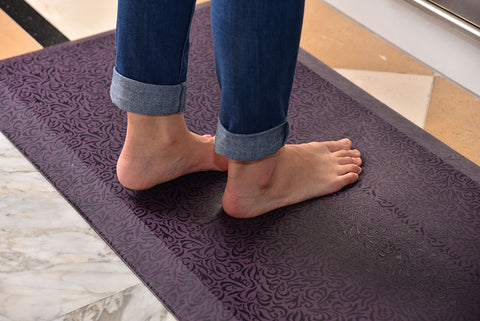Anti-Fatigue Matting Guide
Did you know that standing for even only 90 minutes on a hard, flat surface can result in severe pain in the feet, legs, and back as well as stiffness in the neck and shoulders? That is correct! Long periods of standing reduce blood flow to the lower limbs, resulting in discomfort and weariness. In order to address these problems, anti-fatigue mats support the lower back and legs while encouraging little movements in the leg and calf muscles that lead to enhanced blood and oxygen flow. Standing on a softer surface causes the surface to give way under your weight, reducing pressure from your body and causing an increase in muscular action that promotes the circulation of blood and oxygen.
Employing ergonomic solutions, such as commercial-grade anti-fatigue matting, can increase workers' comfort and productivity.
How Comfort is Measured in Terms of Compression Deflection
Compression Deflection: What Is It? The measurement used to determine an anti-fatigue mat's displacement under pressure is called compression deflection. In essence, it gauges how plush and squishy the carpet will be beneath your feet. So how do they accomplish this? A 150-pound individual would be considered one load when applied at 20 psi (pounds per square inch). A second load of 40 psi, or a 600-pound human, is applied. According to research, both loads should deflect optimally between 20% and 60%. Anything over 60% can be seen as excessively soft, while anything less than 20% can seem too firm. You need something in the centre that feels just perfect, like Goldilocks!
Knowledge of Materials & Performance
An anti-fatigue mat's construction material has a significant impact on the mat's longevity and performance. One of three materials—PVC (vinyl), rubber, polyurethane, or a combination of the first two—makes up the majority of anti-fatigue mats.
PVC (vinyl) is often the material that is utilised the most because it is inexpensive. It is far less resilient than rubber or polyurethane, though. Due to its propensity for tearing, cracking, and curling at the edges, PVC mats might pose a danger. And rubber is far more slip-resistant than PVC. Many PVC mats, in fact, fall short of the basic standards for slip resistance when they are wet. If you choose a PVC anti-fatigue mat, we advise selecting one that is either made of a solid material or whose surface is moulded to the foam foundation rather than bonded to it. This will help the mat last longer by decreasing the possibility of cracking, curling, and delamination.

An anti-fatigue mat made of rubber is a great choice. Although less expensive than polyurethane, it appears to have more advantages, particularly in industrial settings. Nitrile and styrene-butadiene (SBR) are the two main varieties. In an industrial setting, nitrile rubber is likely the best choice for anti-fatigue mats. It is extremely slip-resistant and won't be damaged by grease or oil. Because of its slag resistance, it is safe to use near grinding and welding. Although nitrile rubber is naturally resistant to germs like bacteria, if you are in a situation where bacteria are a concern, we strongly advise utilising a nitrile product that has been treated with an anti-microbial to offer further defence against bacteria and deterioration.

As you might expect, mats made of a combination of nitrile rubber and PVC offer advantages of both materials. The resistance of PVC/nitrile-blended carpets against grease and oil will not be as great as that of pure nitrile. Blended products should not be used in situations with grease, oil, or certain chemicals since they will degrade over time. The are also unsuitable for slag-filled situations.
While providing outstanding comfort and durability in commercial settings, polyurethane, which is normally the priciest of the three materials, typically lacks the attributes required for success in demanding industrial conditions. Polyurethane mats, in general, offer suitable solutions for situations that are oily, dry, or just a little moist. Slag will seriously harm polyurethane because it is only heat-safe up to roughly 400 degrees.







